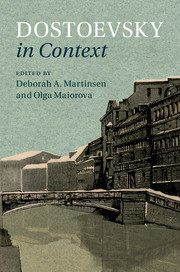Book contents
- Frontmatter
- Contents
- List of illustrations
- Notes on contributors
- Acknowledgments
- Note on citation, transliteration, glossary, and dates
- Chronology
- 1 Introduction: the many worlds of Dostoevsky
- PART I SOCIAL, HISTORICAL, AND CULTURAL CONTEXTS
- PART II LITERATURE, JOURNALISM, AND LANGUAGES
- 25 Modern print culture
- 26 Realism
- 27 Dostoevsky: translator and translated
- 28 Travel and travel writing
- 29 Folklore
- 30 Foreign languages
- 31 Theater
- 32 Dostoevsky's journalism and fiction
- 33 Dostoevsky's journalism in the 1860s
- 34 Dostoevsky's journalism in the 1870s
- 35 Censorship
- Glossary
- Further reading
- Index
- References
29 - Folklore
from PART II - LITERATURE, JOURNALISM, AND LANGUAGES
Published online by Cambridge University Press: 18 December 2015
- Frontmatter
- Contents
- List of illustrations
- Notes on contributors
- Acknowledgments
- Note on citation, transliteration, glossary, and dates
- Chronology
- 1 Introduction: the many worlds of Dostoevsky
- PART I SOCIAL, HISTORICAL, AND CULTURAL CONTEXTS
- PART II LITERATURE, JOURNALISM, AND LANGUAGES
- 25 Modern print culture
- 26 Realism
- 27 Dostoevsky: translator and translated
- 28 Travel and travel writing
- 29 Folklore
- 30 Foreign languages
- 31 Theater
- 32 Dostoevsky's journalism and fiction
- 33 Dostoevsky's journalism in the 1860s
- 34 Dostoevsky's journalism in the 1870s
- 35 Censorship
- Glossary
- Further reading
- Index
- References
Summary
Nineteenth-century Russia witnessed momentous efforts to collect and publish the songs and tales of the people (narod*). In the early decades of the century, a number of factors prompted interest in the narod, including the common people's enormous contribution to the struggle against Napoleon (1812), the influence of Western European folklorists, above all Jacob and Wilhelm Grimm, and the growing conviction that serfdom was both cruel and economically inefficient. Interest in popular lore among educated Russians constituted part of a quest for national identity, and by the 1820s the elusive quality of “Russianness” was often expressed by the word “narodnost’.” By the 1840s the term had become so pervasive that Vissarion Belinsky, the most influential critic of the 1840s, called it “the alpha and omega of the aesthetics of our time.”
Narodnost’, however imprecise as a concept, was perceived to exist most particularly among the common people, especially in what we today term “folklore.” But folk songs and tales were not spared the purview of Russian censorship, especially during the reign of Nicholas I (1825–55). Songs about bandits and popular rebellions were rarely allowed into print, though in fact any type of folklore was suspect, especially if it concerned the harshness and misery of village life. With the ascent of Alexander II (1855–81), restrictions were eased, and a publishing bonanza ensued in which much of the voluminous material collected in the 1830s and 1840s finally appeared. But not everything made it past the censor, even in the second half of the century. Folk legends were especially vulnerable because they often expressed religious views at variance with the Orthodox Church. The ecclesial censor banned Alexander Afanasiev's Russian Folk Legends (1859) on the grounds that it contained blasphemous material.
Dostoevsky's creative life ran parallel to the intense collecting activity of the 1840s and the growth of folklore as a discipline per se in the 1860s and 1870s. The writer was broadly acquainted with the folk repertoire and incorporated multiple references and allusions to belief narratives about demonic spirits and sorcery, religious legends, spiritual songs, laments, and other genres into his great novels. In addition, he was familiar with Old Russian apocryphal tales and the lives of saints, both of which he regarded as reflecting the worldview of the narod.
- Type
- Chapter
- Information
- Dostoevsky in Context , pp. 251 - 257Publisher: Cambridge University PressPrint publication year: 2016



